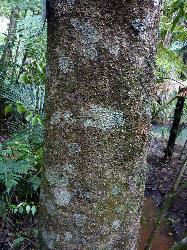- Taxon
- Gallery
- ≡ Laurus tawa A.Cunn., Ann. Nat. Hist. 1: 379 (1838)
- ≡ Nesodaphne tawa (A.Cunn.) Hook.f., Bot. Antarct. Voy. II. (Fl. Nov.-Zel.) Part I, 217 (1853)
- = Laurus victoriana Colenso in , London Journal of Botany 301 (1842) nom. nud.
- = Beilschmiedia tawaroa A.E.Wright, New Zealand J. Bot. 22: 119-123 (1984)
Evergreen tree to 35 m tall; trunk to 1.2 m diam. with buttressed roots when mature; wood white to creamy brown, straight grained; bark smooth, dark brown, often obscured by lighter coloured lichen growth; branching monopodial to give a deep crown of slender to moderately robust branches; branchlets, young leaves, petioles and inflorescence branchlets at first finely pubescent, later ± glabrous; hairs pale golden, simple; leaves opposite to sub-opposite, simple, thinly coriaceous, on petioles (6-)8(-10) mm long; midrib slender to moderate, straight, prominent below; leaf laminae narrow-elliptic, occasionally lanceolate, (31—)43— 73(-86) × (8-)ll-16(-20)mm, yellow-green and glabrous above, glaucous with scattered pale golden hairs below, margins entire and undulate, apex acute to acuminate to shortly caudate, venation reticulodromous; inflorescence an erect, axillary panicle to 100 mm long, lax and pedunculate, bracts narrow-lanceolate and caducous, each flower subtended by 1 or more minute bracteoles; flowers perfect, on pedicels 3-5 mm long, 2-3 mm diam., pale green, perianth of 6 segments, ovate to oblong, stamens 12 (arranged as for genus), ovary unilocular and superior; drupes pendulous, ellipsoid to ovoid, (23-)28(-33) × (9-)12(-15) mm, 1-seeded, pericarp fleshy, ripening through red to dark purple or almost black, glaucous or shiny.
[Reproduced from Wright (1984, New Zealand J. Bot. 22: 109-125) with permission from The Royal Society of New Zealand.]
Flowering: Sep.–Dec.; Fruiting: Oct.–Feb.




